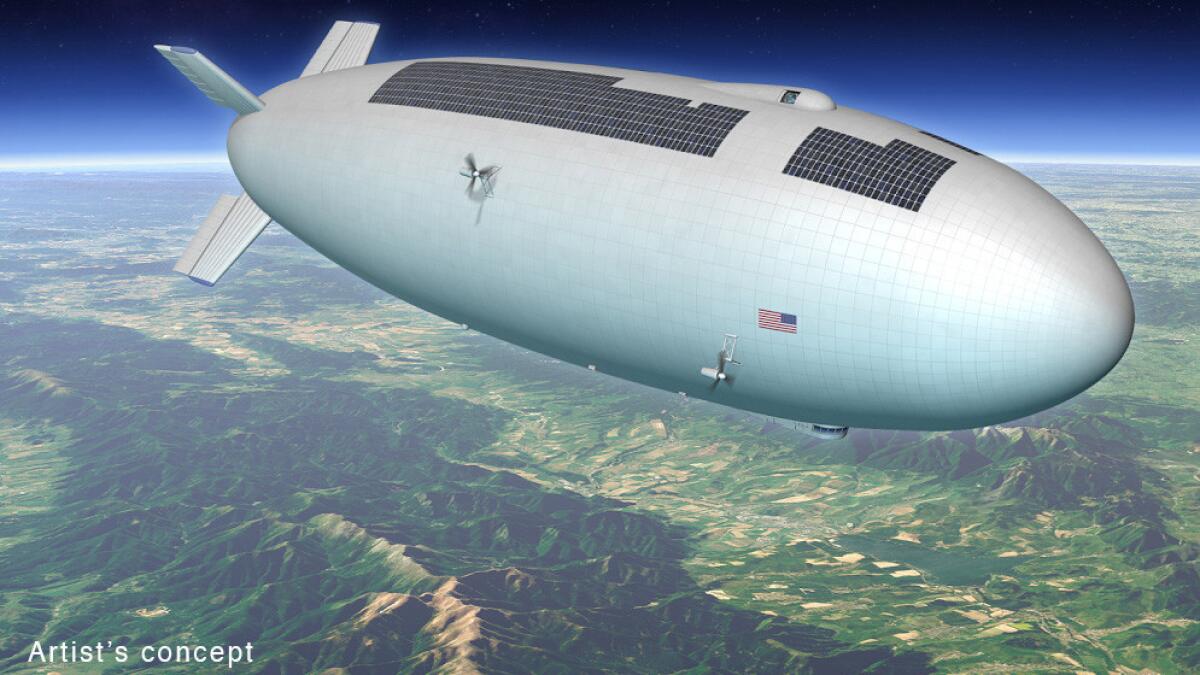A contest to build high-flying airships? NASA’s thinking about it

- Share via
NASA has put telescopes on mountains and telescopes in space – but what about a telescope on a high-flying blimp?
Scientists at the agency’s Jet Propulsion Laboratory are designing a possible contest that could foster the building of airships – giant floating craft that could be used for astronomy and environmental science (and maybe even for setting up Wi-Fi hot spots).
“The science applications are really very wide — and basically limited almost by our imagination,” said JPL cosmologist Jason Rhodes, principal investigator for the challenge’s development.
In the 20-20-20 Airship Challenge, competitors would build craft that could maintain an altitude of 65,000 feet (about 12 miles) above Earth’s surface, partway into the stratosphere. That altitude, Rhodes said, hits an engineering sweet spot: high enough to get above 95% of the atmosphere, but not so high that the air is too thin for a propeller-powered airship to actually move.
There would be two tiers of competition. In the first, aspiring builders would aim to keep an airship with a 20-kilogram load (44 pounds) at an altitude 20 kilometers (12.4 miles) for 20 hours – hence the 20-20-20 name. The second, more ambitious tier would set a goal of carrying 200 kilograms (440 pounds) for 200 hours – 10 times the weight for 10 times as long.
Airships come in a variety of designs. Some, like blimps, are soft-bodied; others, like zeppelins, are rigid.
NASA put out a request for information to get feedback from interested parties, and if enough folks weigh in, they may issue the proposed contest as one of their “centennial challenges” for the first half of 2015, Rhodes said. (Note to the undecided: There’s a cash prize if you win.)
This type of airship could be useful for both scientific and commercial reasons, Rhodes said. High above Earth, airships can see stars more clearly because they escape about 95% of the atmospheric turbulence that interferes with the light reaching ground telescopes. Telescopes mounted on these airships could be used to study black holes, the formation of galaxies, and questions related to that mysterious force known as dark energy.
Airships could also be used to conduct environmental science, hovering over cities and tracking pollution or plant growth for months, or perhaps flying over a hurricane and chasing a storm system for days.
NASA isn’t the only one who could benefit from such airships, Rhodes said. There could well be a market for these airborne vehicles. Companies like Facebook and Google, which have been interested in delivering Wi-Fi to remote areas via drone or balloon, could use an airship instead.
An airship is maneuverable (unlike a balloon) and potentially much more energy-efficient than a drone. Oil companies could keep a watchful eye from the sky on an oil platform in a remote area; shipping companies could use airships to monitor goods passing through pirate-infested waters.
In the end, Rhodes said, the hope is that “the companies that compete will want to sell these airships.”
Satellites whiz by Earth too fast to get more than a look at a given spot roughly every 90 minutes, and they’re expensive to launch, Rhodes pointed out. And satellite-based telescopes can run in the hundreds of millions to billions of dollars. (NASA’s James Webb Space Telescope, for example, is expected to cost about $8.8 billion.)
Airships also take far less time to build than a spacecraft or a ground-based telescope, both of which can take decades to complete.
In fact, that time factor explains why Rhodes got involved with the idea of airships. The cosmologist has been working on potential dark-energy space missions since about 2001, but some of the major upcoming missions he’s affiliated with won’t be launched for many years. The European Space Agency’s Euclid mission is set to launch in 2020, and NASA’s WFIRST mission is planned for 2024. Planning, building and launching a satellite takes time.
An airship, on the other hand, could do some of the same dark-energy science with a much quicker turnaround. With these airborne telescopes, scientists wouldn’t have to wait for a huge chunk of their careers to pass in order to see an endeavor bear fruit.
NASA is asking different parties – companies that might build such airships, scientists who might like to use them, and entities that might be interested in running the contest – for their perspectives and input on the contest’s preliminary outline, as well as an airship’s potential uses.
Officially, the deadline was Dec. 1, but NASA will consider the community input in January. So if you still want to submit your thoughts, you might still have time to chime in.
How would you put an airship to use? Share your thoughts and follow @aminawrite for more science news.







